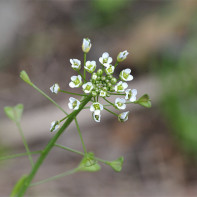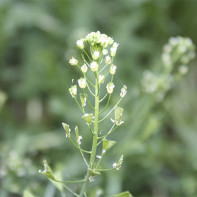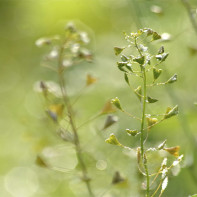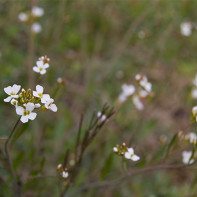Shepherd's bag: medicinal properties and contraindications
A modest-looking plant of the cabbage family is distributed on all continents, almost throughout the territory of Russia and neighboring countries. Other well-known names are heart grass, buckwheat, field eye, passerine eye, swan, ground grass, purse, spoons. Useful properties of the plant have been known for a long time, mention of it is found in sources of Ancient Greece and Ancient Rome.
- Chemical composition
- How it looks and where it grows
- Collection and storage
- The healing properties of grass shepherd's purse
- For women
- For men
- During pregnancy
- For children
- Shepherd's bag in folk medicine
- Cooking Application
- Types of healing compounds
- Infusion
- Tincture
- Decoction
- Tea
- Contraindications
Chemical composition
Shepherd's bag contains a complex of organic acids, a large number of trace elements and other beneficial substances:
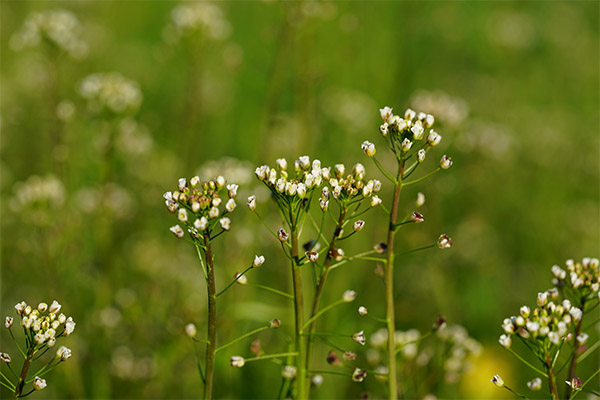
- Vitamin C (ascorbic acid) - helps to strengthen the immune system, protects the body from bacteria and viruses, promotes wound healing, and has a positive effect on blood formation organs. He is involved in the synthesis of collagen, which is needed for the health of cartilage and bone tissue. It is necessary for the removal of toxins, the normalization of the withdrawal of bile and the support of the pancreas.
- Vitamin K (phylloquinone) - helps to normalize blood coagulation, promotes the absorption of calcium in the body, prevents osteoporosis, protects the body from excessive calcium deposition in soft tissues and blood vessels.
- Vitamin B1 (thiamine) - participates in the metabolism of carbohydrates, proteins and fats, protects cells from exposure to toxic substances. Thiamine helps the brain, improve concentration, thought processes, increases learning ability. The intake of thiamine in an adequate amount supports mood, healthy appetite, tone of the muscles of the heart and organs of the gastrointestinal tract, reduces toothache, helps with motion sickness, and improves the state of intoxication.
- Vitamin B4 (choline) - prevents diseases of the nervous system, supports it in a healthy state. Protects liver cells, including while taking toxic drugs, alcohol or with viral diseases. It prevents the formation of gallstones. Choline also reduces the level of "bad" cholesterol, reduces the concentration of fatty acids in the body, promotes the withdrawal of homocysteine, thereby reducing the risk of diseases of the cardiovascular system. It helps maintain normal blood sugar. In type 1 diabetes, the body’s need for insulin decreases. Choline is necessary for the prevention of prostate health, and also increases sperm motility.
- Vitamin B8 (Inositol) - improves metabolism, due to which it is often used in the treatment of obesity, stimulates the brain, helps to focus attention, develop memory, therefore it is often part of vitamin complexes for children and adolescents. Inositol is also important for the health of the nervous system, including the regulation of sleep rhythms. This substance prevents the formation of blood clots in blood vessels, strengthens their walls, therefore it is an important component of the treatment for atherosclerosis.
- Tannins (tannins) - give the plant an astringent and astringent taste, help with intestinal upset, treat diarrhea, have bactericidal and anti-inflammatory properties, which accelerates wound healing and disinfects them. Tannins also help remove toxins from the body, which can be used in complex therapy for radiation exposure. They have hemostatic properties, help with internal and external bleeding.
- Oxalic acid is necessary in the treatment of female and male infertility, chronic tuberculosis, rheumatic and headaches. This acid is able to fight in the body with E. coli, staphylococcus.
- Fumaric acid - in medicine it is part of the means for the treatment of psoriasis, in the cosmetic industry it is used as a part of dandruff shampoos.
- Citric acid - participates in cell renewal, helps slow down the aging process, increases skin elasticity and thus reduces wrinkles. Citric acid is able to remove toxins through the pores of the skin.
- Tartaric acid - due to whitening, moisturizing and exfoliating properties, it is often part of cosmetic lotions, masks, creams. Adding the juice of a shepherd’s bag to a moisturizer or applying a mask of honey, olive oil and a tincture of a shepherd’s bag helps to refresh the complexion, improve its tone, and smooth the skin. In pharmacology, it is added to the means for the treatment of constipation, diseases of the stomach, heartburn, as well as reducing hangover.
- Beta-sitosterol is a plant substance, phytosterol. It is necessary as part of complex therapy for atherosclerosis of blood vessels, to alleviate the condition with menopause, diseases of the prostate gland. It prevents the subsidence of cholesterol in the vessels, cleans them, helps to reduce the frequency of angina attacks.
Flavonoids:
- Diosmin is an active compound, flavonoid. It reduces the extensibility of the veins, improves their tone, prevents blood stasis, improves the fluid exchange in the body, helps to remove its excess and reduce edema. Strengthens the walls of blood vessels, increases the frequency of their contraction, has an anti-inflammatory effect, prevents the onset of inflammatory processes, anesthetizes. Due to its properties, it is used in the composition of medicines for the treatment of varicose veins and hemorrhoids.
- Vitamin P (rutin), bioflavonide. Increases the elasticity of the walls of blood vessels, helps to normalize arterial and intraocular pressure, prevents the development of glaucoma. It has anti-inflammatory, anti-allergenic effect, reduces swelling and cramping, dilates blood vessels. A sufficient amount of it helps the immune system fight colds and infections. Vitamin P is often used for diseases of the gastrointestinal system, rheumatism, atherosclerosis, and hypertension. In case of vitamin P deficiency, hemorrhages in the places of pressure, small bruises can appear on the skin.
- Phytoncides are substances that can destroy or slow down the growth of microorganisms. They contribute to the normalization of heart rhythm, blood pressure, reduce blood sugar, improve cerebral circulation, support the health of the liver and nervous system.
- Potassium - regulates the water content in the tissues of the body, maintains an optimal balance of salts, alkalis and acids, thus helping to reduce swelling. Potassium helps normalize heart rhythm. It supports the activity of the brain, improves its oxygen supply, and alleviates the condition of allergies.
- Copper - with its deficiency, disorders of the gastrointestinal system, anemia, loss of appetite, problems with hair loss and fragility, rash and internal bleeding can occur. Copper is essential for the health of the nervous and digestive systems. It is involved in the conversion of iron to hemoglobin, necessary for the synthesis of collagen, which is responsible for the health of bones, teeth and cartilage. Copper is also important for the production of endorphins necessary to maintain mood.
- Zinc - is necessary for the formation of bone tissue. Helps prevent diabetes, rheumatism, arthritis, prevents the development of epilepsy, promotes wound healing. It is necessary for the assimilation of vitamin A and mental activity, has a positive effect on the condition of hair and teeth.
- Manganese - normalizes the nervous system, stimulates brain activity, helps the production of ascorbic acid (vitamin C). It is necessary to prevent the development of diabetes mellitus, regulates the level of glucose in the body, improves metabolism, and prevents excessive fat deposition in the liver and other organs. Reduces the level of "bad" cholesterol, which is the prevention of cardiovascular disease.
- Chromium - its deficiency causes insomnia, rapid fatigue, increased anxiety, the appearance of headaches, trembling hands, worsening skin and hair. Chromium is necessary for the absorption of fats and carbohydrates, it is responsible for the removal and processing of lipids, it is needed to reduce body weight and maintain normal weight. This element is necessary for the prevention of thyroid diseases and osteoporosis. It stimulates tissue regeneration.
How it looks and where it grows
Thin cirrus leaves grow on a thin stalk 20–50 cm high. Inflorescences from small yellow-white or pinkish flowers look like a neat bag. The fruits have a triangular shape, which at the time of ripening acquire a brown color. The roots of the grass are long and thin. Unpretentious flower grows along roads, on pastures, in fields.
Collection and storage
As a raw material for the manufacture of therapeutic agents use the aerial part of the plant. The collection is carried out during flowering and the appearance of the fruit, but before they ripen. This period lasts from April to June. Harvest grass should be in dry weather, in the daytime, so that the dew has melted. You can extract the whole plant with the roots and then remove them or cut the grass, leaving the roots in the ground.
You can not collect a shepherd's bag, affected by a white coating (fungus) or with signs of decay. A shepherd’s bag that grows along major highways and in other contaminated areas absorbs toxic substances. In this regard, it is better to choose ecologically clean areas for collecting grass.
Fresh stems and leaves are stored very briefly. In baskets, trays, they begin to mold and deteriorate, so there should not be much time between collection and preparation. Dry the collected plants for 5-7 days in the air, avoiding the open sun, so as not to burn raw materials. To speed up the process, you can use a dryer at a temperature of about 40-50 ° C. The plant is ready for storage if the stems become brittle and the leaves become bitter.
Store dried grass in linen bags, boxes of straw or cardboard, paper bags, in a cool dry place. The period during which useful properties are preserved depends on storage conditions, usually 2-3 years.
The healing properties of grass shepherd's purse
Most often, a shepherd’s bag is used as a hemostatic agent. It is also used in combination with other agents for the treatment of hypertension, cystitis, pyelonephritis, has an antipyretic and mild analgesic effect. In the leaves of a shepherd’s bag there is a high concentration of antimicrobial agents that help to disinfect wounds and accelerate their healing.

For women
In folk medicine in Russia, women took a decoction from a shepherd’s bag as a contraceptive. The substances contained in the plant really help delay ovulation and prevent unwanted pregnancy.
Due to the high content of tannins, as well as oxalic acid, decoction from a shepherd’s bag can reduce bleeding and pain, ease the general condition with heavy menstruation.
Vitamin B8 in the purse is important for the health and effective functioning of the reproductive system, especially useful for women who are planning a pregnancy. The same vitamin, provided that it is regularly and sufficiently taken, helps to restore and maintain the health of the hair, and prevents damage and dryness.
Beta-sitosterol contained in the purse activates the synthesis of the female sex hormone estradiol.Under its influence, the skin of the face becomes soft and velvety, wrinkles are smoothed out, and complexion improves. Estradiol improves mood, increases resistance to stress.
The presence of vitamin K makes a shepherd’s bag valuable for women during menopause, since this vitamin promotes the absorption of calcium, respectively, prevents brittle bones, and ensures the health of teeth and hair.
For men
Vitamin B4 as part of a shepherd’s bag is essential for prostate health. It also helps to increase sperm motility, thus helping to combat one of the causes of male infertility.
The content in the purse of oxalic acid makes it an important component in the treatment of problems with potency. These substances help normalize libido, increase testosterone levels, therefore tinctures with a shepherd’s bag are recommended for the treatment and prevention of problems with potency.
Beta-sitosterol as part of a shepherd’s bag is needed to treat prostatic hypertrophy, as well as prostate carcinoma. For the treatment of prostate diseases, it is necessary to take a course of tincture of the purse for 2 weeks, 3 times a day, 2 drops dissolved in half a glass of water.
During pregnancy
A shepherd's bag enhances smooth muscle contraction. It is good for the health of the intestines and stomach, but it is dangerous during pregnancy.
When breastfeeding
There are no contraindications for taking the pouch during breastfeeding. It is necessary to apply decoctions, teas or infusions with it very carefully, starting with small doses. The presence of many different natural potent substances can cause allergies or other negative reactions in a child.
At the same time, during the period of postpartum recovery, a shepherd’s bag can beneficially affect a woman’s body, helping to accelerate uterine contractions.
For children
It is believed that up to 12 years, decoctions and infusions with a shepherd’s bag should not be used, since they can cause disturbances in the gastrointestinal system, allergies or other negative reactions of the child’s body. In the future, children and adolescents should be offered tea with a minimum concentration of shepherd’s bags, gradually increasing the dosage if necessary and in the absence of complications.
Vitamins B1 and B8 contained in a shepherd’s bag help school-age children to master a large amount of knowledge, memorize information, and develop analytical skills.
Tea with a purse, used in the evening, can help normalize sleep, which is also necessary for the growth and development of children. Such a drink is also a natural source of vitamin C, which is especially necessary in the spring and autumn for the prevention of colds.
Shepherd's bag in folk medicine
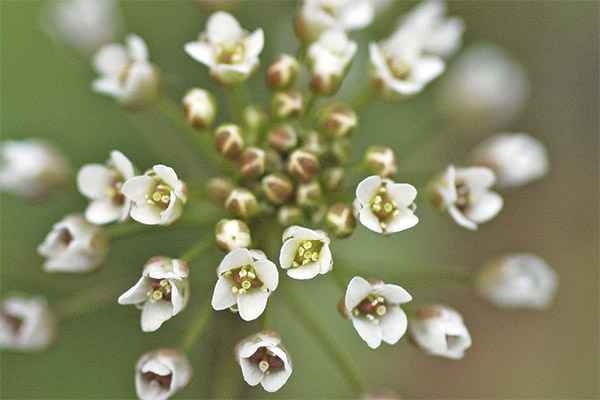
- For the treatment of diseases of the oral cavity and throat. Rinsing with a decoction of a shepherd's bag helps to heal wounds and cracks, alleviate the condition with stomatitis and other lesions of the oral cavity. The procedure should be repeated after each meal for 2-3 days.
- For the treatment of diseases of the gastrointestinal tract. A daily intake of a decoction of a shepherd’s bag at least three times a day (between meals) helps to normalize digestion, reduce inflammation in gastritis and colitis.
- For external use, compresses and ointments are used. A lotion prepared from the tincture of a purse, diluted with water in a ratio of 1: 3, can reduce rashes on the face, normalize oily skin, and remove unwanted shine.
- Juice from a shepherd’s bag can be applied to gauze and applied to the wound surface to accelerate its healing and prevent bacterial infection.It is important to apply a similar compress after the blood stops, a scar will appear.
- The infusion of a shepherd’s bag, applied to a cotton pad, can be applied to the bruise places to reduce tissue swelling and speed up the resolution of the hematoma.
- With pathologies of the kidneys, including urolithiasis, an infusion from a shepherd’s bag helps to reduce inflammation, reduces pain, and helps to remove stones. The course of treatment with infusion should be carried out for at least 2 weeks, it is necessary to take the drug 3 times a day, 2 tablespoons before meals.
- With nosebleeds, you can bury the juice. Fresh leaves are crushed in a mortar or blender, squeezed with gauze juice. Diluted with water in a ratio of 1: 1 and instilled 1-2 drops 2 times a day. Oxalic acid in the shepherd’s bag has a bactericidal effect, inhibits the growth of pathogenic bacteria.
- With hypertension and other diseases of the cardiovascular system, an infusion of a complex of medicinal herbs is recommended. 20 grams of dried herb purse, 20 grams of dried hawthorn flowers, 10 grams of dry valerian root, 10 grams of dried lemon balm leaves are poured with three glasses of boiling water and left in a thermos for 3 hours. Apply the product 3 times a day 15 minutes before meals with a course of at least 2 weeks. Then you need to take a break of at least 10 days and repeat the course.
- To reduce blood pressure, tincture is used, breeding a few drops in 50 grams of water. To achieve a stable result, course treatment is recommended for a week, taking tinctures 3 times a day 30 minutes after a meal.
- With rheumatism and gout, a complex infusion is used to reduce inflammation and relieve pain. 10 grams of dried shepherd’s bag, 10 grams of dried horsetail are poured with boiling water and insisted in a thermos for 2-3 hours. The tool is used for 2 tablespoons before meals for 10 days.
- For bleeding in women associated with childbirth, menorrhagia, menopause, it is recommended to use an infusion of herbal collection: 5 tablespoons of dry purse grass, 5 tablespoons of dried yarrow, 2 tablespoons of dried oak bark, 5 tablespoons of rhizome root mix. One tablespoon of the mixture is poured with a glass of boiling water, insisted for one hour, then filtered. Use half a glass a day before meals for 5 days.
- With gynecological diseases, the use of wine tincture is recommended. It is less strong than tincture of vodka or moonshine, in addition, the beneficial properties of wine have an additional therapeutic effect. Take wine tincture of a shepherd’s bag should be 1 tablespoon 6 times a day for 1 month. After a month's break, the course should be repeated. To prepare the wine tincture of the purse, pour 50 grams of dry grass to 500 ml of dry white wine and leave the composition for 2 weeks in a dry, dark place.
- For inflammatory diseases of the female reproductive system, including provoking infertility, it is recommended to take herbal collection from dry ingredients: 1 tablespoon of dandelion root, 1 tablespoon of clover, 1 tablespoon of marigold flowers, 1 tablespoon of purse, 1 tablespoon of stinging nettle. Grind everything and pour 1.5 liters of cold water. Bring the mixture to a boil and cook for 5 minutes. Then cool the broth and add the boiled water to the evaporated volume. Herbal collection to use one glass half an hour before meals for 5 days before the onset of menstruation. After its beginning, the intake of the broth should be stopped. The herbal collection course should be repeated at least 4 times.
Cooking Application
The purse is often included in various dishes in the cuisine of China, India, the Caucasus and some European countries.In Russia, a shepherd’s bag was called peasant mustard, as it was often used to give a spicy spicy taste to various dishes.

In cooking, fresh leaves are most often used, dried grass is bitter and is used only for therapeutic purposes. The plant is added to salads, soups, side dishes, and baking stuffing. A shepherd's bag goes well with salads and snacks with celery.
Dried seeds can be used as a spicy seasoning instead of pepper or mustard. The seeds are dried, ground in a coffee grinder, poured with boiling water until a sour cream is obtained, sugar and salt are added. This sauce can be seasoned with fish and meat.
Salads with a shepherd’s bag acquire a pleasant aroma and delicate aftertaste.
- One cucumber, one tomato, 100 grams of leaves of a shepherd’s bag, one boiled egg is cut, mixed, salt is added and seasoned with sour cream.
- 100 grams of leaves of the purse are mixed with 250 grams of fresh young white cabbage, one cucumber and two cloves of garlic. To fill such a salad is best with vegetable oil.
- Due to the unique composition of trace elements and vitamins, a shepherd's bag can contribute to weight loss. Dishes with it are suitable for diet food. 4 small potatoes are boiled in water or lean meat broth. 50 grams of onions are fried in vegetable oil with 100 grams of leaves of the purse. Greens are added to the potatoes and the soup is cooked for 5-10 minutes. You can add sour cream to the soup.
In the summer, you can use a shepherd's bag instead of traditional green onions or dill. You can add fresh greens of a shepherd’s bag to the filling of boiled egg and rice for pies made of yeast or puff pastry. Baking will get an original taste and spicy aroma.
In Chinese cuisine, dumplings with the addition of a purse are popular. To prepare them you will need:
- 300 grams of leaves of a shepherd’s bag,
- 200 grams of shiitake mushrooms (can be replaced with champignons),
- 6 eggs
- 5 tablespoons of flour
- 50 grams of green celery,
- 5 boiled shrimp (or a few tablespoons dried),
- salt, as well as other spices and seasonings to taste.
Mushrooms, celery and shrimp are crushed in a blender. If dried mushrooms are used, they are pre-soaked in warm water for 10-15 minutes. 5 eggs beat with salt and fry for 5 minutes, stirring constantly. Shepherd's bag is fried in vegetable oil over high heat for 1–2 minutes. All the ingredients of the filling are mixed. The dough is made from flour, water and eggs. Dumplings can be fried, boiled or steamed.
Types of healing compounds
Depending on the presence of contraindications and the condition of the body, various drinks can be prepared from a shepherd’s bag. In addition, it can be combined with other means, for example, add several spoons of decoction or infusion to honey.
Infusion
2 tablespoons of dried grass pour 200 ml of hot water and for 15 minutes, insist on a water bath, and then cooled for an hour. Then the solution is filtered and plant material is removed from it. The liquid is added to boiled water to 200 ml and brought to a boil. The resulting infusion is poured into a jar and left in a cool dark place. It can be used for two days.
Infusion can be prepared in a simpler way: add 15 grams of dried grass to a thermos, pour a glass of boiled water, close the lid tightly and leave for 2 hours.
Tincture
Dried grass is poured with vodka so that the liquid level is 1/3 of the volume above the plant material. Withstand tincture for at least 3 weeks. After that, grass is removed from it and stored in a cool dark place. Instead of tincture, juice diluted in vodka in a ratio of 1: 5 can be used.
Decoction
To prepare, add dried grass to water in a ratio of 1 gram per 30 ml of water. The broth is brought to a boil and left over low heat for 30 minutes, then filtered.The broth can be stored in a dry, dark place for up to 3 days.
Tea
You can make tea from one shepherd’s bag by adding 1 teaspoon of grass to 1 cup of water. You can also combine the purse with other herbs, such as chamomile, thyme, linden.
Contraindications
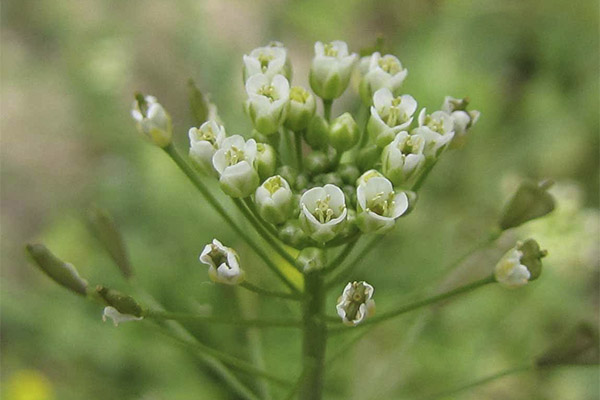
The effect on blood coagulation and contraction of smooth muscle makes taking a shepherd’s bag undesirable in the following cases:
- tendency to low blood pressure;
- increased blood coagulation;
- vascular thromboembolism;
- pregnancy.
In case of kidney diseases or metabolic disorders, inadvertent use of the purse can provoke the formation of stones in the gall or bladder, since the shepherd’s bag contains a large amount of oxalic acid, which combines with calcium and crystallizes in the body.
«Important: all information on the site is provided exclusively in fact-finding purposes. Before applying any recommendations, consult with a profile specialist. Neither the editors nor the authors are liable for any possible harm caused materials. "

